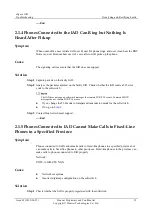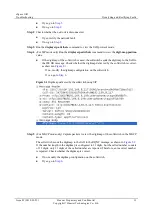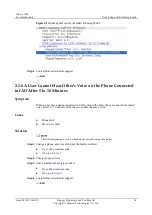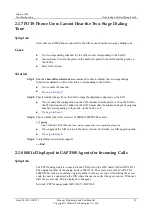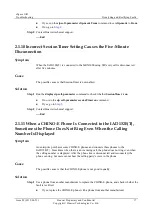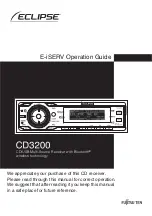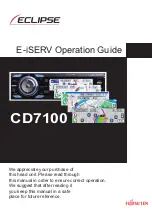
eSpace IAD
Troubleshooting
1 Overvie w
Issue 02 (2012-02-29)
Huawei Proprietary and Confidential
Copyright © Huawei Technologies Co., Ltd.
6
Item
Description
server information.
VLAN configuration
Tag configuration for various packets generated by the IAD.
Current configuration
Current user configuration on the device.
Alarm history
Latest 10 alarms. To view more alarm information, view
downloaded files.
For details about how to query other system information, see the
eSpace IAD Product Documentation
.
1.3.2 Determining the Fault Category
Upon receiving fault information, determine whether the fault is an emergency fault. If the
fault is emergent, contact Huawei technical support. If the fault is not emergent, locate and
rectify the fault according to this document.
1.3.3 Locating and Rectifying a Fault
Troubleshooting refers to locating faults using fault locating methods provided by devices and
rectifying the faults using various methods such as maintaining cables, replacing components,
and modifying configuration data.
The procedure for locating a fault is as follows:
1.
Ver ify that the fault is a peripheral fault.
2.
Ver ify that the fault is an IAD hardware fault.
3.
Ver ify that the fault is a network fault.
4.
Ver ify that the fault is a service fault.
For details, see the common cases.
1.3.4 Verifying Fault Rectification
After taking measures to rectify a fault, verify that the fault is rectified.
If the fault is rectified, compile a troubleshooting report. If the fault is not rectified,
Huawei technical support engineers.
1.3.5 Contacting Technical Support
Huawei Technologies Co., Ltd. provides customers with comprehensive technical support and
service. Please feel free to contact our local office or company headquarters.
Huawei Technologies Co., Ltd.
Address: Administration Building, Huawei Technologies Co., Ltd., Bantian, Longgang
District, Shenzhen, P. R. China
Postal Code: 518129

















